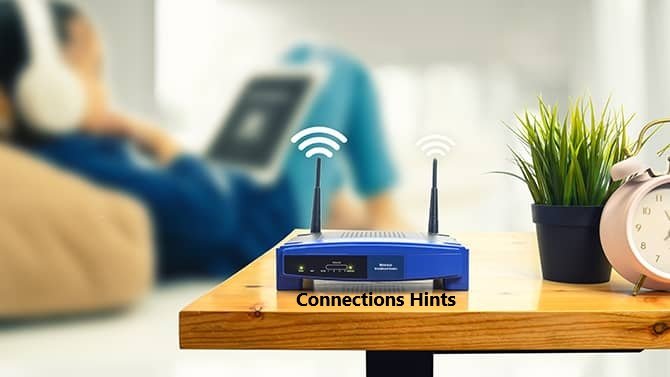In today’s digital world, a reliable home network is essential. Whether working from home, streaming movies, or gaming online, having a fast and stable internet Connections Hints can make a big difference. But achieving optimal performance takes more than just plugging in your router. Fortunately, with a few tech tips and tricks, you can enhance your home network and maximize your internet connection. Here’s how.
Understanding the Basics of Home Networking “Connections Hints”
Before diving into optimization tips, let’s go over the basic components of a home network. Generally, a home network consists of a modem, router, and connected devices. There are three main types of home networks:
- Wired Networks – These use Ethernet cables to connect devices directly to the router, offering faster and more reliable connections Hints.
- Wireless Networks (Wi-Fi) – These networks provide flexibility by allowing devices to connect wirelessly but may be prone to signal interference and speed drops.
- Hybrid Networks – Combining both wired and wireless elements, hybrid networks can deliver a balance of speed, stability, and convenience.
Why Home Network Optimization Matters
An optimized home network is crucial for a smooth internet experience. With more devices connecting to home networks than ever before, a poorly configured network can result in slow speeds, buffering, and even dropped Connections Hints. A well-tuned network offers multiple benefits, such as:
- Increased Speed and Reliability – Enhances performance, reducing buffering and lag.
- Improved Coverage – Ensures strong signal throughout the home, even in hard-to-reach areas.
- Better Security – Protects your network from potential threats and unauthorized access.
Essential Tech Tips to Improve Your Home Network
1. Assessing Your Internet Speed and Bandwidth Needs
Understanding your household’s internet requirements is the first step in optimizing your network. To find your ideal speed:
- Calculate Household Usage: Consider how many people and devices will be using the internet. For basic browsing and streaming, speeds of 25 Mbps may be sufficient, while households with gamers or heavy streamers might require 100 Mbps or more.
- Test Your Current Speed: Use tools like Speedtest.net to determine your current download and upload speeds. If your speeds fall short, you might need to upgrade your plan or address bottlenecks within your network.
2. Choosing the Right Router for Your Home
The router is the backbone of your home network. Selecting the right router is essential for network stability and speed. Here’s what to consider:
- Single-band vs. Dual-band vs. Tri-band Routers: Single-band routers operate on a 2.4 GHz frequency and are more susceptible to interference. Dual-band routers offer both 2.4 GHz and 5 GHz frequencies, which can help minimize interference and increase speed. Tri-band routers add 5 GHz band, ideal for heavy usage.
- Coverage and Range: Make sure the router’s coverage area matches your home’s size. Larger homes or those with thick walls may benefit from a high-range router or additional extenders.
3. Strategic Router Placement
Where you place your router can significantly impact your network’s performance. Avoid hiding it in a cabinet or placing it near large metal objects. Here are some placement tips:
- Central Location: Position your router in the center of your home to maximize coverage.
- Elevate the Router: Placing it on a higher shelf can improve signal strength, as Wi-Fi signals spread downward and outward.
- Avoid Obstacles: Keep it away from thick walls, metal objects, and electronic devices that may interfere with the signal.
4. Updating Router Firmware Regularly
Router manufacturers periodically release firmware updates to improve performance, patch vulnerabilities, and add new features. Staying up to date is simple:
- Log in to your router’s admin panel, usually accessible through a web browser.
- Check the “Firmware Update” section, and if an update is available, follow the prompts to install it.
- Restart the router after the update to ensure changes take effect.
5. Enhancing Wi-Fi Signal Strength
If you’re dealing with dead zones, weak signals, or just need more coverage, Wi-Fi extenders and mesh networks can help.
- Wi-Fi Extenders: These devices boost your Wi-Fi signal by repeating it, expanding coverage to areas that your router alone can’t reach.
- Mesh Networks: A mesh network uses multiple nodes to blanket your home in Wi-Fi coverage. This setup is ideal for larger homes or spaces with tricky layouts, as it ensures seamless coverage and smooth handoffs between nodes.
Advanced Tips for Optimizing Home Network Performance
6. Utilizing Quality of Service (QoS) Settings
QoS is a handy feature for households with diverse network needs. By prioritizing certain types of traffic, QoS ensures your most important activities run smoothly.
- Accessing QoS Settings: Go to your router’s admin panel, and look for QoS options.
- Setting Priorities: Assign higher priority to devices or applications that need a strong connection, like streaming services or gaming consoles, while deprioritizing less critical activities.
7. Securing Your Home Network
Security is a top priority, especially with the increase in cyber threats. Protect your network by:
- Setting a Strong Password: Replace the default password with a complex one containing a mix of letters, numbers, and symbols.
- Enabling WPA3 Encryption: Most modern routers support WPA3, which provides stronger security compared to older encryption standards like WPA2.
- Disabling WPS: While convenient, Wi-Fi Protected Setup (WPS) can be a security risk, as it’s susceptible to brute-force attacks.
8. Managing Network Traffic Effectively
Monitoring your network can help you identify and resolve bandwidth-hogging activities. Here’s how:
- Network Monitoring Tools: Use apps or your router’s built-in features to track device usage and see which activities consume the most data.
- Reducing Unnecessary Traffic: Limit background downloads and updates on devices. Also, close unused tabs and apps on connected devices to free up bandwidth.
9. Investing in a Powerline Adapter for Extended Coverage
For areas where Wi-Fi coverage is insufficient, a Powerline adapter can help. This device uses your home’s electrical wiring to transmit internet signals, effectively extending your network.
- How to Set Up a Powerline Adapter: Plug one adapter into an outlet near your router and connect it with an Ethernet cable. Place the second adapter in the area needing coverage and connect it to your device.
- Benefits: Powerline adapters are particularly useful for connecting gaming consoles or streaming devices in rooms with weak Wi-Fi signals.
Maintaining Your Home Network for Long-Term Efficiency
To keep your network running smoothly, perform regular checks:
- Reboot Your Router Periodically: Restarting your router can resolve minor connectivity issues and refresh Connections Hints.
- Check for Device Updates: Ensure all connected devices have the latest software updates, as outdated software can cause compatibility and security issues.
Conclusion
Optimizing your home network is essential for a seamless internet experience, and it doesn’t have to be complicated. By understanding the basics, choosing the right equipment, and following these simple tech tips, you can enhance your home network’s performance, security, and reliability. Take action today, and enjoy a faster, more reliable connection at home.
FAQs
- How can I tell if my router is outdated?
- If you frequently experience slow speeds and dropped Connections Hints, or if your router doesn’t support the latest security protocols (like WPA3), it may be time for an upgrade.
- What are mesh networks, and are they worth it?
- Mesh networks provide seamless Wi-Fi coverage across large areas and are ideal for homes with dead zones. They are worth it if you need consistent coverage without dead spots.
- How often should I update my router firmware?
- Check for firmware updates every few months or whenever you experience connectivity issues. Regular updates ensure your router runs efficiently and securely.
- Can I use multiple routers to extend my Wi-Fi?
- Yes, using multiple routers can extend coverage. You can connect them through Ethernet or set up a mesh network for easier management.
- How does Quality of Service (QoS) help with streaming?
- QoS prioritizes streaming devices and apps, reducing buffering and providing a smoother viewing experience even when multiple devices are connected.
Also, Read. iZoneMedia360.com: The Hub for Next-Gen Digital Media Tools.




